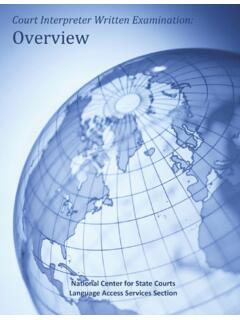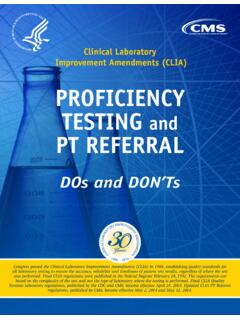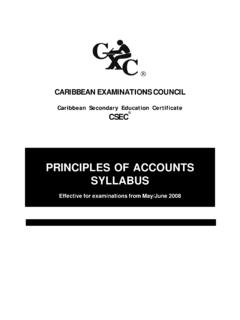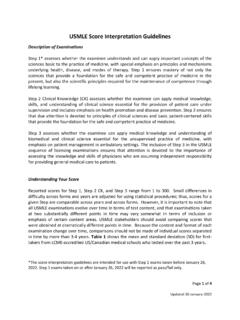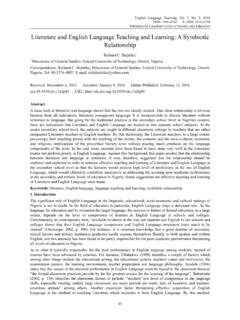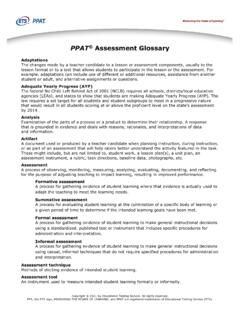Transcription of Chapter 2 – Student Performance Analysis
1 29 Chapter 2 Student Performance Analysis Introduction This Chapter describes Student Performance in the Clark County School District (CCSD) and compares it to that of three peer districts that have similar Student populations but higher academic achievement. It highlights the findings from an extensive Analysis of Student scores over the past six years on state proficiency exams and English fluency assessments. This description of proficiency rates, achievement gaps among Student subgroups, and trends over time shows that Student Performance remains far below state standards and CCSD s own targets, and substantial achievement gaps have persisted.
2 In addition, this Chapter describes the factors that peer districts attribute to their success. These are offered as recommendations to assist CCSD in taking dramatic steps to significantly improve Student academic achievement. Findings included in this Chapter summarize two separate research reports regarding Student Performance in CCSD. The report, Analysis of Student Performance , provides detailed analyses of CCSD Student proficiency rates and English fluency results, broken down by Student subgroups and grade levels. The Comparative Analysis of Academic Performance describes how the three peer districts were selected and compares their Student Performance and trends over time with those of CCSD for reading and math, limited English proficient (LEP) students, Advanced Placement participation and test scores, PSAT scores, and graduation and dropout rates.
3 It also provides a detailed description of peer district efforts to improve their students Performance . Summary of Key Findings and Recommendations The Analysis of CCSD Student Performance data and the experiences of peer districts clearly justify the CCSD Board of Trustees recent decision to take dramatic steps to significantly improve Student achievement. Superintendent Jones has outlined an aggressive strategy to accelerate the pace of growth in A Look Ahead, Phase I: Preliminary Reforms Report6, and many initiatives were underway before this study commenced. The review team endorses the direction of the district s new leadership, and believes that the recommendations contained in this report will help support a new era of educational reform at CCSD.
4 Based on an extensive examination of the CCSD Student achievement data and the comparative Analysis of CCSD Performance and that of peer districts, the review team makes the following recommendations for future CCSD efforts: 6 A Look Ahead: Phase 1 Preliminary Reforms Report Improving Achievement in the Clark County School District Superintendent of Schools Dwight D. Jones (May 2011) 30 1. Curriculum consistency and alignment. A common success factor of the peer districts was the consistency and alignment across its schools in curriculum and programs offered. As stated by one interviewee: We were spending millions and getting very inconsistent is a fiduciary responsibility [to select a program] and go with it implement it with fidelity, and give it three to five years to evaluate it over time.
5 Even in the districts that were more decentralized, it was their structure of networks and consistent communication that helped to keep schools and teachers moving in the same direction. Based on findings contained in Chapter 3 Academic Programs and Services of this report, CCSD s lack of alignment and consistency are critical issues and several recommendations are made in that Chapter to develop cross-functional teams, reduce the number of academic programs and interventions, and align professional development with the curriculum. 2. Focused professional development and support. Considered critical to peer districts improved Performance , high quality professional development is offered through ongoing sessions, coaching, support from experts, and resources provided in-person and on-line.
6 Professional development is focused on specific programs and Student populations, including LEP students. As discussed in Chapter 3 Academic Programs and Services, CCSD was found to have overlapping and sometimes conflicting professional development coming from multiple, uncoordinated sources. Recommendations are made to better align and streamline professional development offerings to serve the needs of teachers and students more efficiently and effectively. The district is also realigning its educational support structure from a geographic orientation to one based on Performance zones. This will better match and focus district resources and school needs.
7 3. Use of data. In peer districts, assessments are used to identify students in need of support and monitor their progress as well as to determine the most appropriate instruction and interventions. Data are made available to teachers and administrators through generated reports and web portals, and the results of these assessments are regularly discussed. CCSD is already moving in this direction with the development of an academic data dashboard that should help facilitate the types of Analysis already taking place in the peer districts. In Chapter 5 Operational Cost Efficiency Review, (Section 4, Technology) of this report, a recommendation is made to develop a comprehensive data management framework to ensure that CCSD data going into the dashboards are clean, accurate, and rigidly defined.
8 4. Intensive attention to particular subject areas and Student subgroups. The Analysis of CCSD data indicates that achievement in science is particularly low and specific subgroups are having the most difficulty attaining proficiency status on state assessments. Redoubled efforts to support their academic achievement is merited for: Hispanic students. Hispanic students are the largest subgroup in the CCSD Student population. Although the achievement gap between Hispanic and White students has narrowed somewhat over time, it is still substantial. Given that more than one-third of Hispanic students who took the CRT are either non- or limited-English 31 speakers, increased efforts to support these students in learning English as well as subject matter content could decrease this achievement gap.
9 Black/African American students. The achievement gap between Black/African American and White students is very large across all subject areas and does not appear to be decreasing over time. Focused attention on the needs of this subgroup is warranted. LEP students. Additional attention to the needs of the LEP Student population is necessary, especially to factors that peer districts report have contributed to their success: - Intense professional development: In the peer districts, teachers who instruct LEP students receive extensive professional development, both internal to the district and through state certification/endorsement specifically related to this Student population (required by law in Florida).
10 - Consistent curriculum and oversight of implementation: Peer districts ensure that schools have a consistent curriculum and supplemental materials available to all LEP students. Monitoring also takes place to ensure that these programs are implemented as planned and are moving students towards English fluency. - Students in grades kindergarten through two: Data Analysis revealed that these students are the least likely of all grade levels to be fluent in English within CCSD. The proportion of children in grades K 2 who are fluent in English is much smaller in CCSD than in the peer districts. These districts cite their intensive intervention programs for young LEP students as a factor in their overall success.










